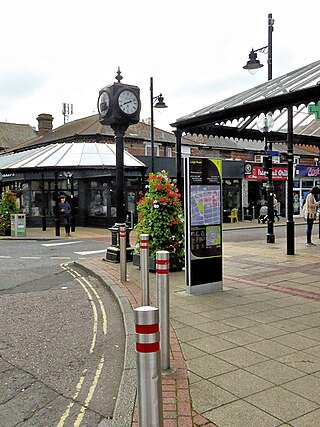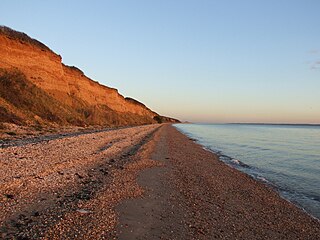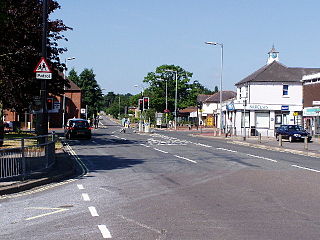
The River Hamble in south Hampshire, England, rises near Bishop's Waltham and flows for 10.1 km (6.3 mi) through Botley, Bursledon, and Lower Swanwick before entering Southampton Water between Hamble Common and Warsash.

The Borough of Eastleigh is a local government district with borough status in Hampshire, England. It is named after its main town of Eastleigh, where the council is based. The borough also contains the town of Hedge End along with several villages, many of which form part of the South Hampshire urban area.

The Borough of Fareham is a local government district with borough status in Hampshire, England. Its council is based in Fareham. Other places within the borough include Portchester, Hill Head, Sarisbury, Stubbington, Titchfield and Warsash. The borough covers much of the semi-urban area between the cities of Southampton and Portsmouth, and is part of the South Hampshire conurbation. The neighbouring districts are Eastleigh, Winchester, Portsmouth and Gosport. The district's southern boundary is the coast of the Solent.

Hill Head is a residential area and village on the coast of the Solent. It is located south of Stubbington, west of Lee-on-the-Solent and south east of Titchfield, in the borough of Fareham, Hampshire.

Hamble-le-Rice, commonly known as Hamble, is a village and civil parish in the Borough of Eastleigh in Hampshire, England. It is best known for being a flying training centre during the Second World War and is a popular yachting location. The village and the River Hamble also featured in the 1980s BBC television series Howards' Way. The village centre, known as The Square, Hamble, has a more traditional English village aesthetic which differentiates it from the small industrial areas close to the village.
There were a number of shipbuilders and shipwrights called Philemon Ewer in the villages of Bursledon and Hamble in the River Hamble area of Hampshire, England during the 18th century.
Swanwick is a village in Hampshire, England, east of the River Hamble and north of the M27 motorway. The village is located within the borough of Fareham and is the site of the London Area Control Centre (LACC) and the London Terminal Control Centre (LTCC), part of National Air Traffic Services Air Traffic Control Centre, and Bursledon Brickworks, the last remaining example of a Victorian steam-powered brickworks.

Titchfield is a village and former civil parish in the Fareham district, in southern Hampshire, England, by the River Meon. The village has a history stretching back to the 6th century. During the medieval period, the village operated a small port and market. Near to the village are the ruins of Titchfield Abbey, a place with strong associations with Shakespeare, through his patron, the Earl of Southampton.

Hedge End is a town and civil parish in Hampshire, England. Situated to the east of the City of Southampton, it adjoins the districts of West End and Botley. Hedge End lies within the Borough of Eastleigh and is part of the Southampton Urban Area. The original hamlet developed on Botley Common after 1250 when it was granted to the men of Botley as common pasture. In 1267, royal charters allowed Botley to hold an annual fair and a weekly market on the common which eventually became a market town.

Warsash is a village in southern Hampshire, England, situated at the mouth of the River Hamble, west of the area known as Locks Heath and south of Sarisbury. Boating plays an important part in the village's economy, and the village has a sailing club. It is also home to the Warsash Maritime Academy, part of Southampton Solent University, which provides training for Merchant Navy Officers from around the world.
George Parsons was an English shipbuilder.

Locks Heath is a residential suburb of Fareham, in the south of Hampshire, England. Locks Heath is immediately surrounded by a collection of villages including Sarisbury to the west, Swanwick, Park Gate and Whiteley to the north, Warsash to the southwest and Titchfield to the southeast. Within the heart of the area its shopping village is located with a community centre. The population of the village itself in 2011 was 7,104 whilst the wider Locks Heath residential area equaled 43,359 as of 2011.

HMS Anson was a 60-gun fourth rate ship of the line of the Royal Navy, built at Bursledon by Philemon Ewer to the draught specified by the 1745 Establishment, and launched on 10 October 1747.
The Southampton–Fareham line is a railway line in England, along the south coast of Hampshire. As a through line it came late in British Railway history, traversing unpromising coastal terrain. The first part from Portswood, near Southampton, to Netley was opened in 1866, prompted by the establishment of the Royal Victoria Hospital at Netley, which had been established for the care of wounded soldiers.

Sarisbury is a village to the west of Park Gate within the borough of Fareham, Hampshire, in the south of England. Its focal point is Sarisbury Green and the parish church of St Paul, formerly part of Titchfield parish. In previous times it was a rural locality dependent on fruit growing. At the 2011 Census the population of the ward was 7,385. Nearby villages include Bursledon, Hamble-le-Rice and Swanwick. The name is pronounced 'Sarsbury' with the 'i' being silent.

Lower Swanwick is a village on the River Hamble in Hampshire, England. It is located within the borough of Fareham at the eastern end of Bursledon Bridge, which carries the A27 across the River.

The Brickworks Museum, also known as Bursledon Brickworks, is a volunteer-run museum in Swanwick, Hampshire, England. It is purportedly the UK's sole surviving Victorian steam-driven brickworks.

Swanwick Shore Strict Baptist Chapel is a Strict Baptist place of worship in Lower Swanwick, a village in the Borough of Fareham in Hampshire, England. It has been in continuous use for worship since 1844, when it succeeded a converted boat-shed which had become unsuitable. Worshippers had gathered there since 1835, led by a pastor who had previously attended a different chapel nearby and who continued to lead the congregation until his death in 1892. Historic England has listed the simple brick building at Grade II for its architectural and historical importance.

Hamble Valley is a parliamentary constituency of the House of Commons in the UK Parliament. Further to the completion of the 2023 Periodic Review of Westminster constituencies, it was first contested in the 2024 general election, when is won by Paul Holmes of the Conservative Party. He served as the MP for Eastleigh from 2019 to 2024.

















